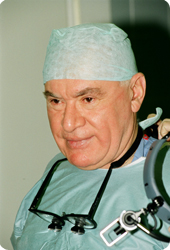Chief Editor
Leo A. Bockeria, MD, PhD, DSc, Professor, Academician of Russian Academy of Sciences, President of Bakoulev National Medical Research Center for Cardiovascular Surgery
Sort by
Perfusion changes in the white matter of the brain in multiple sclerosis according to MRI data
Authors:
Company:
1 The Institute “International Tomography Center” of the Siberian Branch of the Russian Academy of Sciences, Novosibirsk, Russian Federation
2 Novosibirsk Regional Center of Multiple Sclerosis and other Autoimmune Diseases of the Nervous System of Novosibirsk State Regional Clinical Hospital, Novosibirsk, Russian Federation
3 Novosibirsk National Research State University, Novosibirsk, Russian Federation
E-mail: Сведения доступны для зарегистрированных пользователей.
DOI:
UDC: 616.832-004.2-073.756.8
Link: Clinical Physiology of Blood Circulaiton. 2024; 21 (2): 117-126
Quote as: Vasilkiv L.M., Stankevich Yu.A., Bogomyakova O.B., Korobko D.S., Malkova N.A., Tulupov A.A. Perfusion changes in the white matter of the brain in multiple sclerosis according to MRI data. Clinical Physiology of Circulation. 2024; 21 (2): 117–126 (in Russ.). DOI: 10.24022/1814-6910-2024-21-2-117-126
Received / Accepted: 03.06.2024 / 20.06.2024
DownloadAbstract
Multiple sclerosis is one of the common demyelinating diseases, characterized by multifocal symptoms. Currently, there is a discussion about the participation of vascular changes in the formation of neurological disorders. The dynamic susceptibility contrast (DSC) magnetic resonance imaging (MRI) technique allows one to evaluate hemodynamics at the capillary level in vivo.
Objective. To evaluate changes in blood flow at the microcirculatory level in multiple sclerosis using the DSC-technique. Materials and methods. The MR study was carried out on a super-high-angle MR-scanner “Ingenia” (“Philips”) 3 Tesla. The study included 30 healthy volunteers, 71 patients with multiple sclerosis aged 18 to 48 years (mean age was 34.6 ± 8.02 years) and 9 patients with clinically isolated syndrome aged 24 to 38 years (mean age was 29 ± 5.7 years). Quantitative and qualitative assessment of perfusion parameters in demyelination foci and normal-appearing white matter (NAWM) was performed.
Results. Quantitative assessment of perfusion in the NAWM in all groups showed a significant decrease in the cerebral blood flow velocity and volume by 14% and 7%, respectively, starting with a сlinically isolated syndrome and with an increase in the severity of these changes as the disease progresses. Changes in perfusion in demyelination foci are a dynamic process depending on the stage of evolution of demyelination foci.
Conclusion. Assessment of cerebral perfusion allows us to take a new look at the role of the vascular component in the process of formation of focal inflammatory changes in the brain in MS, which can determine a new direction for pathogenetic treatment.
References
- Lapointe E., Li D.K.B., Traboulsee A.L., Rauscher A. What have we learned from perfusion MRI in multiple sclerosis? AJNR Am. J. Neuroradiol. 2018; 39 (6): 994–1000. DOI: 10.3174/ajnr.A5504
- Koudriavtseva T., Lorenzano S., Cellerino M., Truglio M., Fiorelli M., Lapucci C. et al. Tissue factor as a potential coagulative / vascular marker in relapsing-remitting multiple sclerosis. Front. Immunol. 2023; 14: 1226616. DOI: 10.3389/fimmu.2023.1226616
- Thompson A.J., Baranzini S.E., Geurts J., Hemmer B., Ciccarelli O. Multiple sclerosis. The Lancet. 2018; 10130 (391): 1549–1636. DOI: 10.1016/S0140-6736(18)30481-1
- Inglese M., Petracca M. MRI in multiple sclerosis: clinical and research update. Curr. Opin. Neurol. 2018: 31 (3): 249–255. DOI: 10.1097/WCO.0000000000000559
- Anderhalten L., Wohlrab F., Paul F. Emerging MRI and biofluid biomarkers in the diagnosis and prognosis of multiple sclerosis. Lancet Reg. Health Eur. 2024; 44: 101023. DOI: 10.1016/j.lanepe.2024.101023
- Chertcoff A., Schneider R., Azevedo Ch.J., Sicotte N., Oh J. Recent advances in diagnostic, prognostic, and disease-monitoring biomarkers in multiple sclerosis. Neurol. Clin. 2024; 42 (1): 15–38. DOI: 10.1016/j.ncl.2023.06.008
- Koudriavtseva T., Stefanile A., Fiorelli M., Lapucci C., Lorenzano S., Zannino S. et al. Coagulation/complement activation and cerebral hypoperfusion in relapsing-remitting multiple sclerosis. Front. Immunol. 2020; 11: 548604. DOI: 10.3389/fimmu.2020.548604
- Mascali D., Villani A., Chiarelli A.M. Pathophysiology of multiple sclerosis damage and repair: linking cerebral hypoperfusion to the development of irreversible tissue loss in multiple sclerosis using magnetic resonance imaging. Eur. J. Neurol. 2023; 30 (8): 2348–2356. DOI: 10.1111/ene.15827
- de la Peña M.J., Peña I.C., Polo García P.G., Gavilán M.L., Malpica N., Rubio M. et al. Early perfusion changes in multiple sclerosis patients as assessed by MRI using arterial spin labeling. Acta Radiol. Open. 2019; 8 (12): 2058460119894214. DOI: 10.1177/2058460119894214
- Zhou Q., Zhang T., Meng H., Shen D., Li Y., He L. et al. Characteristics of cerebral blood flow in an Eastern sample of multiple sclerosis patients: a potential quantitative imaging marker associated with disease severity. Front Immunol. 2022; 13: 1025908. DOI: 10.3389/fimmu.2022.1025908
- Berry D.B., Englund E.K., Chen Sh., Frank L.R., Ward S.R. Medical imaging of tissue engineering and regenerative medicine constructs. Biomater. Sci. 2021; 9 (2): 301–314. DOI: 10.1039/d0bm00705f.
- Stankevich Yu.A., Rezakova M.V., Bogomyakova O.B., Shraybman L.A., Tulupov A.A. Hemodynamic effects of pathological tortuosity of the internal carotid arteries based on MRI and ultrasound studies. Applied Magnetic Resonance. 2015; 46 (10): 1109– 1120.
- Shraibman L., Bogomyakova O., Stankevich Y., Tulupov A. Asymmetry of cerebral venous outflow. Experimental & Clinical Cardiology. 2014; 20 (8): 3963–3968.
- Tulupov A., Savelyeva L., Bogomyakova O., Prygova Y. Cerebral venous thrombosis: diagnostic features of phase-contrast MR angiography. Applied Magnetic Resonance. 2011; 41 (2): 551–560. DOI: 10.1007/s00723-011-0261-1
About Authors
- Lyubov M. Vasilkiv, Cand. Med. Sci., Radiologist, Senior Researcher at the Neuroscience Laboratory; ORCID
- Yuliya A. Stankevich, Cand. Med. Sci., Radiologist, Senior Researcher at the Neuroscience Laboratory; ORCID
- Olga B. Bogomyakova, Cand. Med. Sci., Radiologist, Researcher at the Laboratory “MRT Technologies”; ORCID
- Denis S. Korobko, Cand. Med. Sci., Neurologist, Head of the Novosibirsk Regional Center for Multiple Sclerosis and Other Autoimmune Diseases of the Nervous System; Senior Researcher of the Neuroscience Laboratory; ORCID
- Nadezhda A. Malkova, Dr. Med. Sci., Neurologist, Curator at the Novosibirsk Regional Center of Multiple Sclerosis and other Autoimmune Diseases; Leading Researcher of the Neuroscience Laboratory; ORCID
- Andrey A. Tulupov, Dr. Med. Sci., Professor, Corresponding Member of Russian Academy of Sciences, Radiologist, Head of the Laboratory «MRT Technologies», Chief Researcher at the Neuroscience Laboratory; ORCID
If you found mistakes, select text and press Alt+A




